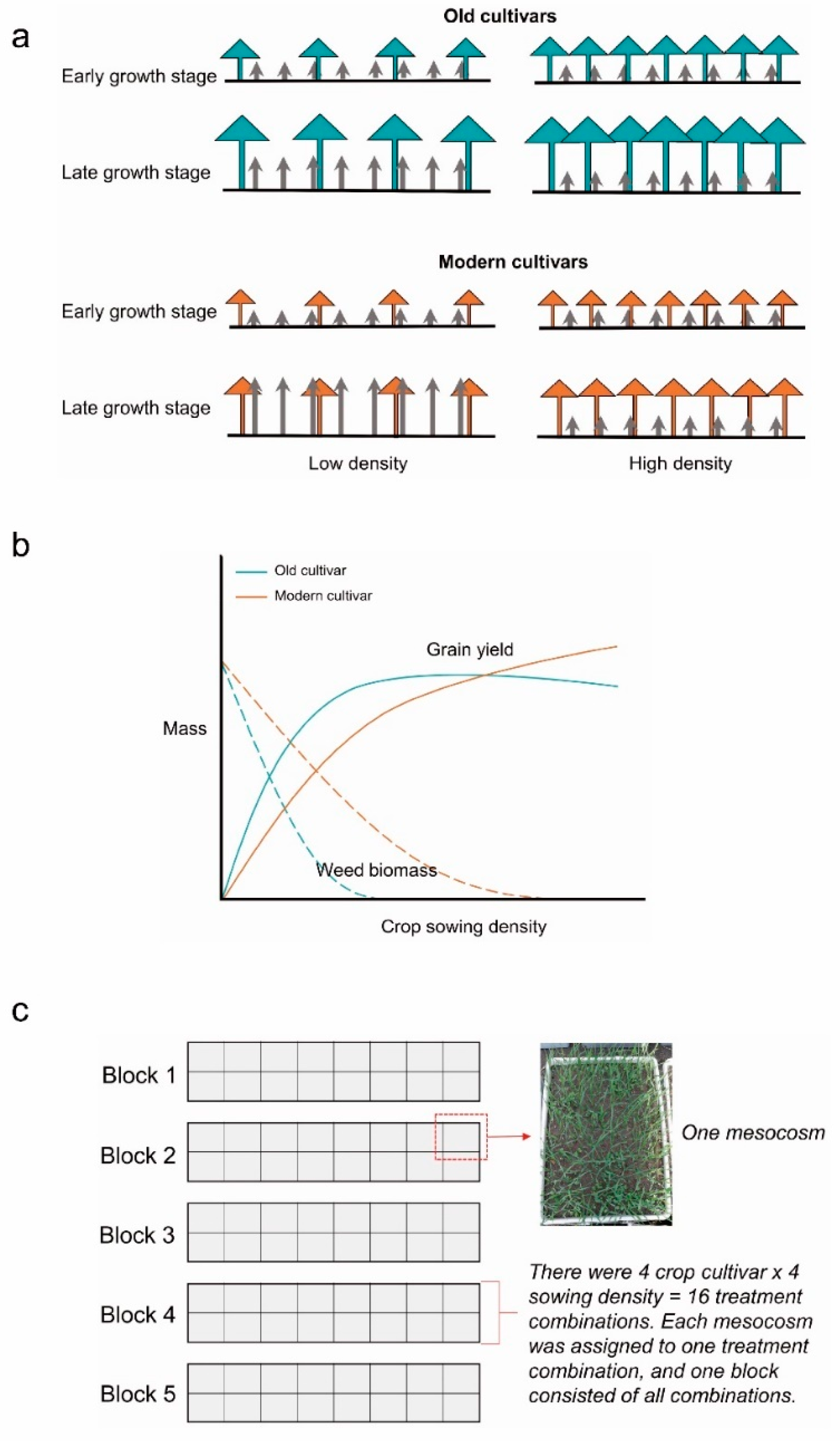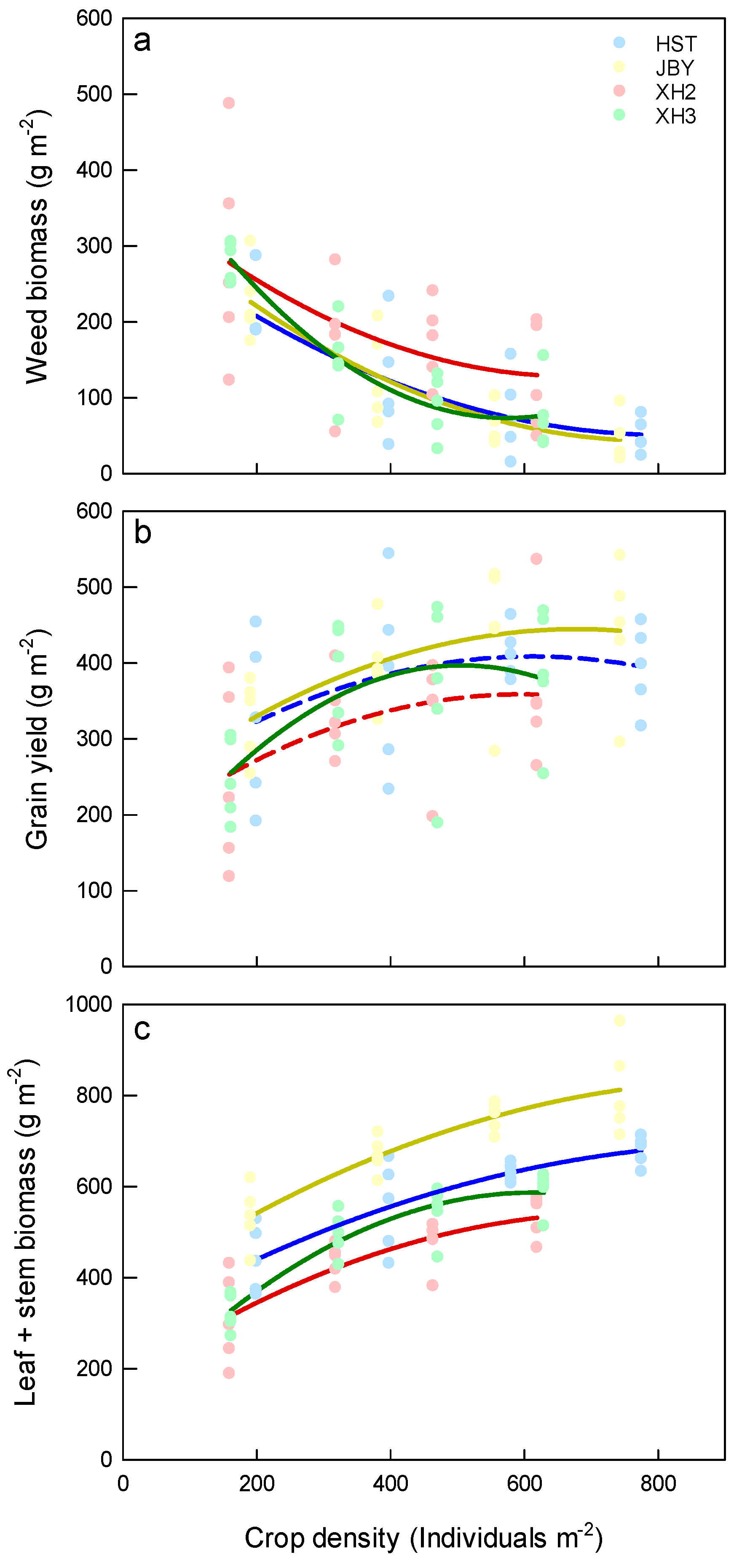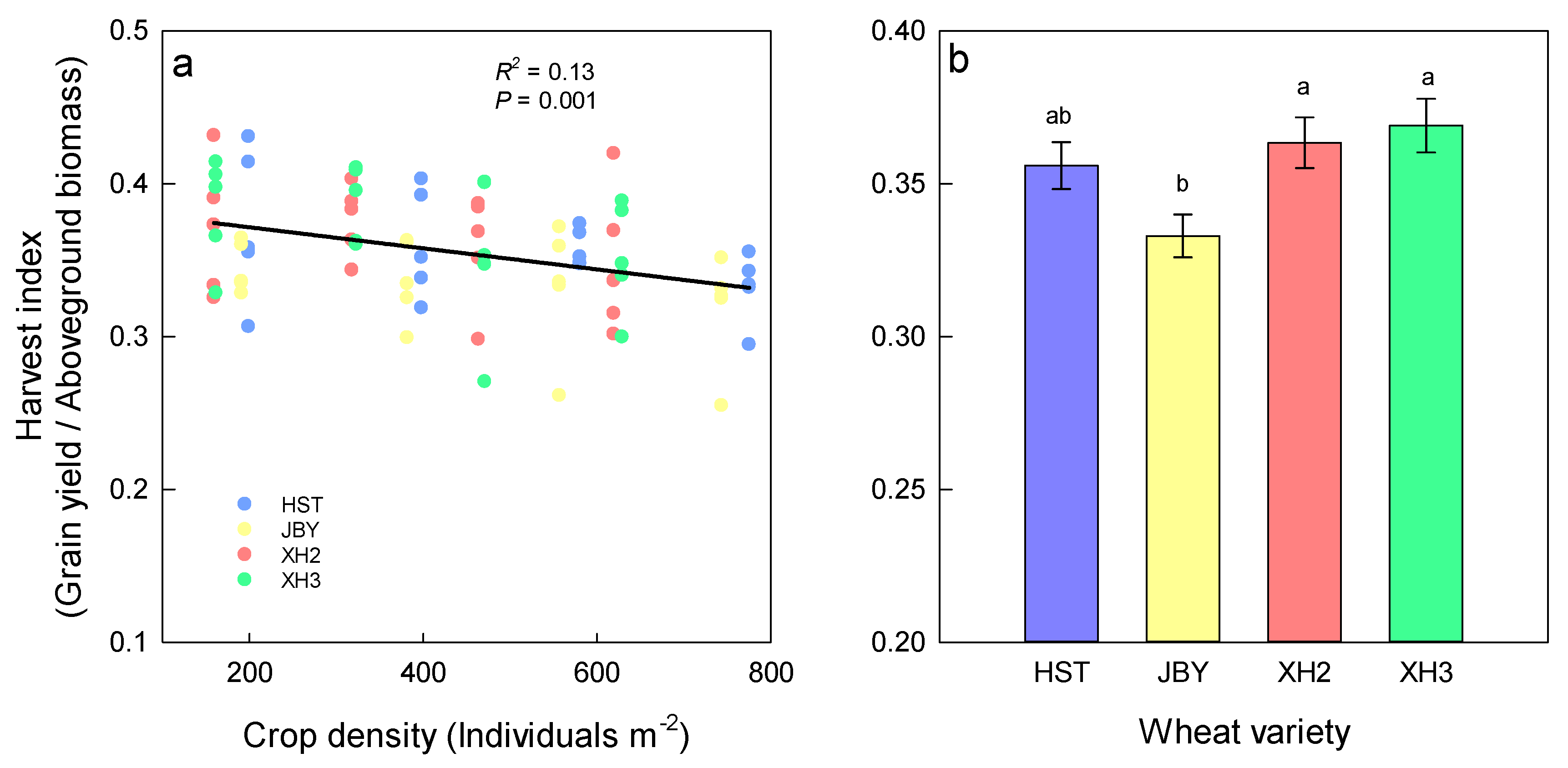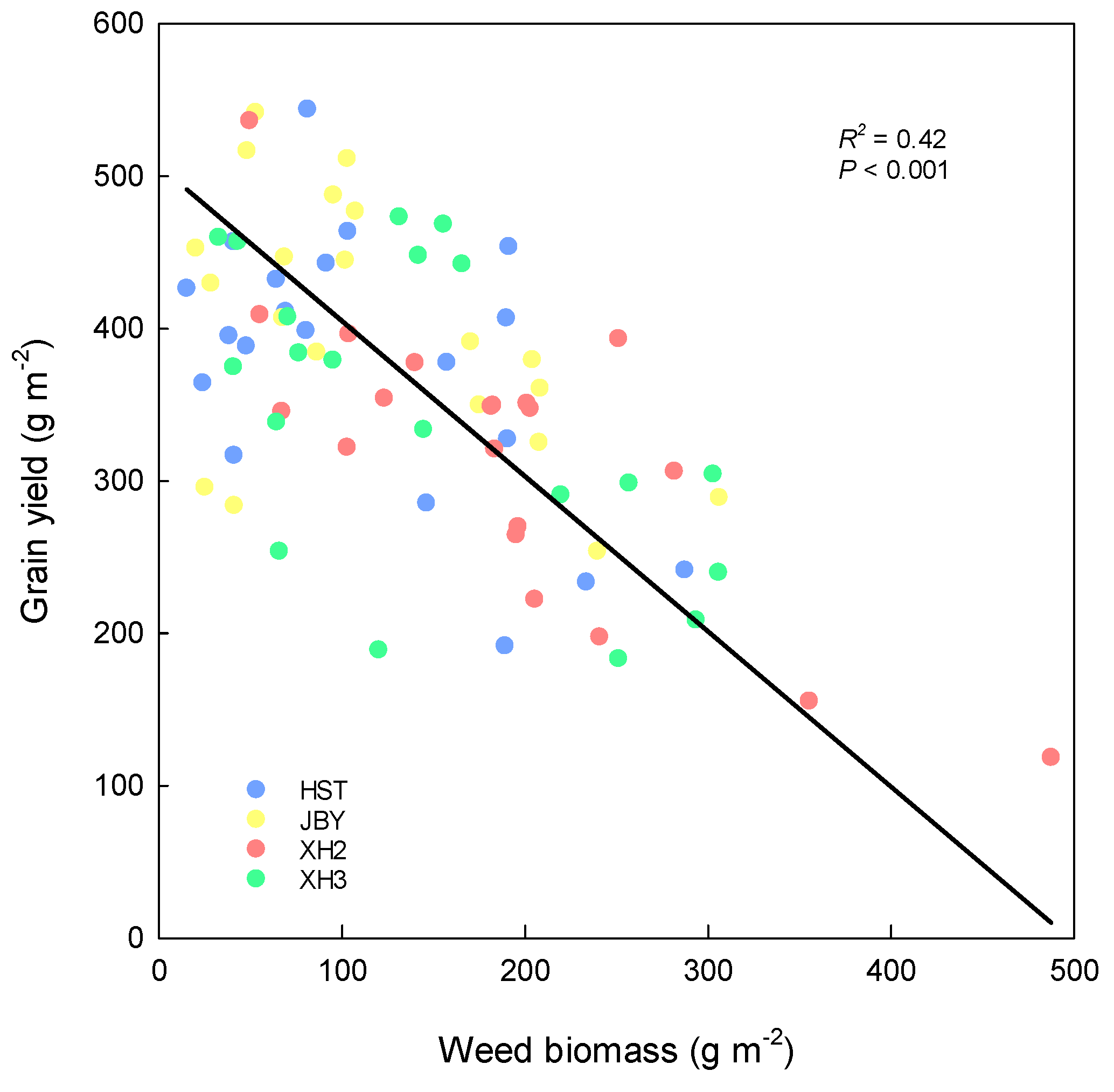Differences in Weed Suppression between Two Modern and Two Old Wheat Cultivars at Different Sowing Densities
Abstract
:1. Introduction
2. Materials and Methods
2.1. Materials
2.2. Experimental Design
2.3. Statistical Analyses
3. Results
4. Discussion
5. Conclusions
Supplementary Materials
Author Contributions
Funding
Data Availability Statement
Acknowledgments
Conflicts of Interest
References
- Clark, M.S.; Ferris, H.; Klonsky, K.; Lanini, W.T.; van Bruggen, A.H.C.; Zalom, F.G. Agronomic, economic, and environmental comparison of pest management in conventional and alternative tomato and corn systems in northern California. Agric. Ecosyst. Environ. 1998, 68, 51–71. [Google Scholar] [CrossRef]
- Oerke, E.C. Crop losses to pests. J. Agric. Sci. 2006, 144, 31–43. [Google Scholar] [CrossRef]
- Guyton, K.Z.; Loomis, D.; Grosse, Y.; El Ghissassi, F.; Benbrahim-Tallaa, L.; Guha, N.; Scoccianti, C.; Mattock, H.; Straif, K. Carcinogenicity of tetrachlorvinphos, parathion, malathion, diazinon, and glyphosate. Lancet Oncol. 2015, 16, 490–491. [Google Scholar] [CrossRef]
- Hijosa-Valsero, M.; Bécares, E.; Fernández-Aláez, C.; Fernández-Aláez, M.; Mayo, R.; Jiménez, J.J. Chemical pollution in inland shallow lakes in the Mediterranean region (NW Spain): PAHs, insecticides and herbicides in water and sediments. Sci. Total Environ. 2016, 544, 797–810. [Google Scholar] [CrossRef]
- Martinez, D.A.; Loening, U.E.; Graham, M.C. Impacts of glyphosate-based herbicides on disease resistance and health of crops: A review. Environ. Sci. Eur. 2018, 30, 2. [Google Scholar] [CrossRef] [Green Version]
- Quintaneiro, C.; Soares, A.M.V.M.; Monteiro, M.S. Effects of the herbicides linuron and S-metolachlor on Perez’s frog embryos. Chemosphere 2018, 194, 595–601. [Google Scholar] [CrossRef]
- Andrew, I.K.S.; Storkey, J.; Sparkes, D.L. A review of the potential for competitive cereal cultivars as a tool in integrated weed management. Weed Res. 2015, 55, 239–248. [Google Scholar] [CrossRef]
- Weiner, J.; Andersen, S.B.; Wille, W.K.M.; Griepentrog, H.W.; Olsen, J.M. Evolutionary agroecology: The potential for cooperative, high density, weed-suppressing cereals. Evol. Appl. 2010, 3, 473–479. [Google Scholar] [CrossRef]
- Denison, R.F. Darwinian Agriculture: How Understanding Evolution Can Improve Agriculture; Princeton University Press: Princeton, NJ, USA, 2012. [Google Scholar]
- Fang, Y.; Liu, L.; Xu, B.C.; Li, F.M. The relationship between competitive ability and yield stability in an old and a modern winter wheat cultivar. Plant Soil 2011, 347, 7–23. [Google Scholar] [CrossRef]
- Weiner, J.; Du, Y.L.; Zhang, C.; Qin, X.L.; Li, F.M. Evolutionary agroecology: Individual fitness and population yield in wheat (Triticum aestivum). Ecology 2017, 98, 2261–2266. [Google Scholar] [CrossRef] [Green Version]
- Zhang, D.Y.; Sun, G.J.; Jiang, X.H. Donald’s ideotype and growth redundancy: A game theoretical analysis. Field Crops Res. 1999, 61, 179–187. [Google Scholar] [CrossRef]
- Craine, J.M. Competition for nutrients and optimal root allocation. Plant Soil 2006, 285, 171–185. [Google Scholar] [CrossRef]
- Hardin, G. The tragedy of the commons. Science 1968, 162, 1243–1248. [Google Scholar] [PubMed]
- Rankin, D.J.; Bargum, K.; Kokko, H. The tragedy of the commons in evolutionary biology. Trends Ecol. Evol. 2007, 22, 643–651. [Google Scholar] [CrossRef] [PubMed] [Green Version]
- Donald, C.M. The breeding of crop ideotypes. Euphytica 1968, 17, 385–403. [Google Scholar] [CrossRef]
- Austin, R.B.; Bingham, J.; Blackwell, R.D.; Evans, L.T.; Ford, M.A.; Morgan, C.L.; Taylor, M. Genetic improvements in winter wheat yields since 1900 and associated physiological changes. J. Agric. Sci. 1980, 94, 675–689. [Google Scholar] [CrossRef]
- Zhu, L.; Xi, N.; Zhang, D.Y. Lower sensitivity in responses to root competition and soil resource availability in a new wheat cultivar than in an old wheat landrace. Plant Soil 2020, 450, 557–565. [Google Scholar] [CrossRef]
- Zhu, L.; Zhang, D.-Y. Donald’s ideotype and growth redundancy: A pot experimental test using an old and a modern spring wheat cultivar. PLoS ONE 2013, 8, e70006. [Google Scholar] [CrossRef]
- Lemerle, D.; Verbeek, B.; Cousens, R.D.; Coombes, N.E. The potential for selecting wheat varieties strongly competitive against weeds. Weed Res. 1996, 36, 505–513. [Google Scholar] [CrossRef]
- Vandeleur, R.K.; Gill, G.S. The impact of plant breeding on the grain yield and competitive ability of wheat in Australia. Aust. J. Agric. Res. 2004, 55, 855–861. [Google Scholar] [CrossRef]
- Schwinning, S.; Weiner, J. Mechanisms determining the degree of size asymmetry in competition among plants. Oecologia 1998, 113, 447–455. [Google Scholar] [CrossRef] [PubMed]
- Lu, P.; Jiang, B.; Weiner, J. Crop spatial uniformity, yield and weed suppression. Adv. Agron. 2020, 161, 117–178. [Google Scholar] [CrossRef]
- Weiner, J.; Griepentrog, H.W.; Kristensen, L. Suppression of weeds by spring wheat Triticum aestivum increases with crop density and spatial uniformity. J. Appl. Ecol. 2001, 38, 784–790. [Google Scholar] [CrossRef]
- Olsen, J.; Kristensen, L.; Weiner, J.; Griepentrog, H.W. Increased density and spatial uniformity increase weed suppression by spring wheat. Weed Res. 2005, 45, 316–321. [Google Scholar] [CrossRef]
- Marín, C.; Weiner, J. Effects of density and sowing pattern on weed suppression and grain yield in three varieties of maize under high weed pressure. Weed Res. 2014, 54, 467–474. [Google Scholar] [CrossRef]
- R Core Team. R: A Language and Environment for Statistical Computing; R Foundation for Statistical Computing: Vienna, Austria, 2018. [Google Scholar]
- Denison, R.F. Evolutionary tradeoffs as opportunities to improve yield potential. Field Crops Res. 2015, 182, 3–8. [Google Scholar] [CrossRef]
- Weiner, J. Looking in the wrong direction for higher-yielding crop genotypes. Trends Plant Sci. 2019, 24, 927–933. [Google Scholar] [CrossRef]
- Namuco, O.S.; Cairns, J.E.; Johnson, D.E. Investigating early vigour in upland rice (Oryza sativa L.): Part I. Seedling growth and grain yield in competition with weeds. Field Crops Res. 2009, 113, 197–206. [Google Scholar] [CrossRef]
- Ogg, A.G.; Seefeldt, S.S. Characterizing traits that enhance the competitiveness of winter wheat (Triticum aestivum) against jointed goatgrass (Aegilops cylindrica). Weed Sci. 1999, 47, 74–80. [Google Scholar] [CrossRef]
- Olsen, J.M.; Griepentrog, H.W.; Nielsen, J.; Weiner, J. How important are crop spatial pattern and density for weed suppression by spring wheat? Weed Sci. 2012, 60, 501–509. [Google Scholar] [CrossRef]





| Effects | df | F Value | p Value |
|---|---|---|---|
| Density | 1, 60 | 279.42 | <0.0001 |
| Variety | 3, 60 | 6.93 | 0.0004 |
| Leaf + stem biomass (LS biomass) | 1, 60 | 11.16 | 0.0014 |
| Density × variety | 3, 60 | 2.98 | 0.0384 |
| Density × LS biomass | 1, 60 | 3.04 | 0.0862 |
| Variety × LS biomass | 3, 60 | 0.65 | 0.5838 |
| Density × variety × LS biomass | 3, 60 | 1.34 | 0.2683 |
| Effects | df | F Value | p Value |
|---|---|---|---|
| Density | 1, 60 | 27.64 | <0.0001 |
| Variety | 3, 60 | 2.75 | 0.0506 |
| Weed biomass | 1, 60 | 23.06 | <0.0001 |
| Density × variety | 3, 60 | 0.12 | 0.9485 |
| Density × weed biomass | 1, 60 | 2.55 | 0.1153 |
| Variety × weed biomass | 3, 60 | 0.71 | 0.5515 |
| Density × variety × weed biomass | 3, 60 | 1.39 | 0.2550 |
| Effects | df | F Value | p Value |
|---|---|---|---|
| (a) Leaf + stem biomass | |||
| Density | 1, 68 | 235.10 | <0.0001 |
| Variety | 3, 68 | 42.95 | <0.0001 |
| Density × variety | 3, 68 | 0.64 | 0.5900 |
| (b) Harvest index | |||
| Density | 1, 68 | 13.45 | 0.0005 |
| Variety | 3, 68 | 3.54 | 0.0192 |
| Density × variety | 3, 68 | 0.13 | 0.9409 |
Publisher’s Note: MDPI stays neutral with regard to jurisdictional claims in published maps and institutional affiliations. |
© 2021 by the authors. Licensee MDPI, Basel, Switzerland. This article is an open access article distributed under the terms and conditions of the Creative Commons Attribution (CC BY) license (http://creativecommons.org/licenses/by/4.0/).
Share and Cite
Wu, Y.; Xi, N.; Weiner, J.; Zhang, D.-Y. Differences in Weed Suppression between Two Modern and Two Old Wheat Cultivars at Different Sowing Densities. Agronomy 2021, 11, 253. https://doi.org/10.3390/agronomy11020253
Wu Y, Xi N, Weiner J, Zhang D-Y. Differences in Weed Suppression between Two Modern and Two Old Wheat Cultivars at Different Sowing Densities. Agronomy. 2021; 11(2):253. https://doi.org/10.3390/agronomy11020253
Chicago/Turabian StyleWu, Yue, Nianxun Xi, Jacob Weiner, and Da-Yong Zhang. 2021. "Differences in Weed Suppression between Two Modern and Two Old Wheat Cultivars at Different Sowing Densities" Agronomy 11, no. 2: 253. https://doi.org/10.3390/agronomy11020253






